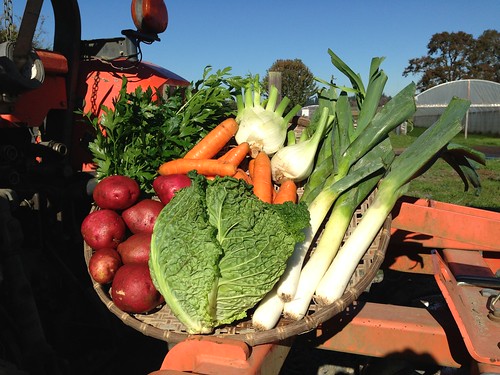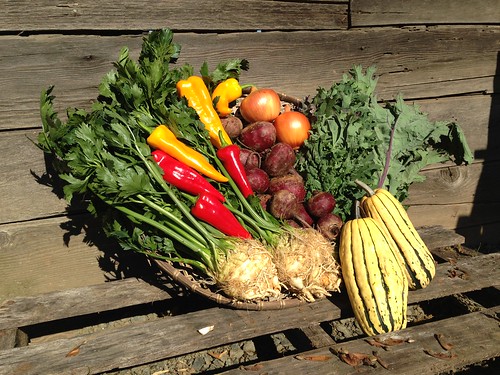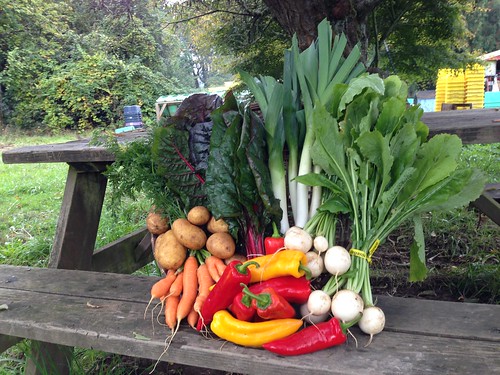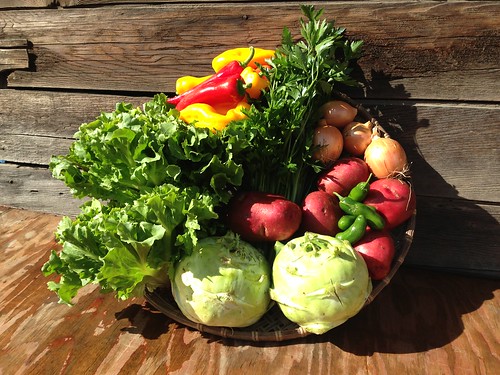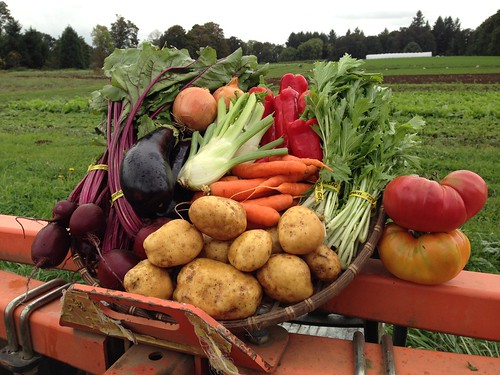The roasted savoy cabbage wedges with a simple vinaigrette seems like it won’t amount to much. It does! It’s a perfect dish. Please make it! Happy cooking!
Braised Cabbage with Apple Cider, White Wine and Vinegar
Roasted Cabbage Wedges with Vinaigrette
Fennel, Carrot and Parsley Salad
Mustard Roasted Potatoes, Carrots and Fennel
Potato Leek Soup
Potatoes with Salsa Verde I & II
Braised Cabbage with Apple Cider, White Wine and Vinegar
This is a simple and delicious way to work your way through a lot of cabbage. I ate ¼ of a cabbage in one sitting I think prepared this way recently—and a quarter of a big (!) cabbage.
Preheat oven to 375 – 400 (my oven runs cool so I tend to always go higher)
Use however much cabbage you want/need to use up. Remove the outer most leaves, cut the cabbage in quarters and remove the core. Now carefully cut the cabbage into wedges about 2 inches wide, trying to keep the wedges together as best you can. Place the wedges snugly next to each other in a baking dish.
Generously sprinkle with sea salt and drizzle with olive oil. Pour in about 1/3 cup of dry white wine (if you’re using an 8 x 13” baking dish) and 1/3 cup of apple cider. Bake the cabbage for about 45 minutes until nicely browned and tender when pierced with a fork. Remove from the oven and drizzle with about 2 teaspoons of good sherry or balsamic vinegar. Return to the oven for 5 more minutes and then serve.
Roasted Cabbage Wedges with Vinaigrette
–adapted from The Yellow House
The cabbage gets tender on the inside and caramelized and crispy on the outside and is so simple and delicious this way. If you have a large head of cabbage this will probably be more than you can eat in one sitting like this but the roasted cabbage is so good that I would suggest roasting the whole thing and using any leftover wedges in other ways later in the week.
1 head savoy cabbage
1-2 tablespoons olive oil
Sea salt
For the vinaigrette:
5-6 tablespoons olive oil
3 tablespoons sherry vinegar
1 teaspoon Dijon-style mustard
Sea salt
Fresh ground black pepper
Pecorino Romano or Parmesan for serving (optional)
Preheat the oven to 450 degrees.
Using a large, sharp knife, quarter the cabbage. Depending on the size of your cabbage, these quarters may be good size already. If they seem too large for one plate, halve each of the quarters so you have eight cabbage wedges, or more if they’re still quite large. Trim away any very pithy or brown ends of the core, but leave the core intact. The core will hold the wedges together while roasting.
Arrange the cabbage wedges on a baking sheet. Drizzle the cabbages with the olive oil, and then sprinkle liberally with sea salt.
Transfer the baking sheet to the oven. Roast the cabbage for 30 minutes, flipping the wedges at 15 minutes so they brown evenly. At the conclusion of roasting, the cabbages may have some blackened, crispy outer leaves. If you don’t want this, feel free to take them out a few minutes early, but note that the inside of the cabbage may be less tender than if you had left it in longer.
While the cabbage is roasting, make your vinaigrette by whisking together olive oil, sherry vinegar, and mustard. Taste the vinaigrette and season with salt and pepper to taste.
When the cabbage is tender, serve the wedges, drizzled with vinaigrette, and a good grating of cheese over the top. Serve immediately, while the cabbage is still hot.
Mustard Roasted Vegetables
This is a nice variation to plain roasted vegetables. One of my favorite things to do with these, once roasted and a bit cooled is to toss them with lots of parsley. Then add a bit more lemon juice and olive oil and make a big salad out of it. Quantities are approximations. Use however many vegetables you want in whatever ratio you want.
Preheat oven to 400 degrees
1 medium onion, cut in half and sliced in ½-inch thick half-rounds
5 potatoes, scrubbed but not peeled and cut into wedges
6-7 carrots, scrubbed and cut into ½ – ¾-inch slices on the bias
1 head fennel, trimmed and cut into ½-inch thick sliced and then cut in half
2-3 tablespoons whole grain mustard
2 tablespoons olive oil
Zest of 1 lemon
1 garlic clove, minced (optional)
Sea salt and freshly ground pepper
Chopped parsley, for tossing with at the end
Put all the vegetables in a big bowl. Mix the other ingredients in a small bowl and then toss the mustard mixture with the vegetables mixing very well. I use my hands to get it thoroughly mixed—messy but fun and effective.
Spread the vegetables on a rimmed baking sheet—try not to crowd and use two sheets if you have too much for one. Roast for 20 minutes then stir and keep roasting until all vegetables are tender and beginning to brown around the edges.
Toss with a bit of vinegar and/or lemon juice and chopped parsley if you’d like (see headnote) and serve hot or at room temp.
Fennel, Carrot and Parsley Salad
As you’ve probably heard me say before I didn’t use to like raisins in savory food but looking back over the recipes I’ve created or adapted here I see a handful of them with raisins and I think I have to stop saying that. And I particularly like golden raisins in some of these dishes. Whether or not you have/had a similar aversion, give this a try.
1 bulb fennel, trimmed and sliced as thinly as you can
2 carrots, julienned or gated on large holes of a box grater
3 tablespoons chopped parsley
1 small shallot (or 2 scallions or a piece of a regular onion, very thinly sliced)
½ cup golden raisins
Zest of 1/2 lemon, finely grated on a micro-plane
Juice of 1 lemon (or more)
Sea salt and freshly ground pepper
3 tablespoons good olive oil
Toss all ingredients together well. Let sit for 10 minutes. Toss again and taste and adjust seasoning. You need plenty of salt to offset all the lemon.
This would be delicious with any kind of fish!
Potato Leek Soup
–adapted from Around my French Table by Dorie Greenspan
This classic is worth repeating. Simple, luscious and always rewarding. You could make fancy croutons by tossing them in lots of chopped parsley and minced garlic and toasting just a little more.
2 tablespoons unsalted butter
1 large onion, chopped (or 1-2 extra leeks)
2 garlic cloves, thinly sliced
Salt and freshly ground pepper
3 leeks, white and light green parts only, split lengthwise, washed, and thinly sliced
3 medium potatoes, peeled and cubed
6 thyme sprigs, leaves stripped
2 fresh sage leaves (optional), finely chopped
4 cups veggie bouillon, chicken stock, or water
3 cups whole milk
Optional Toppings:
Minced fresh parsley
Grated Parmesan or Gruyere
Croutons
Melt the butter in a large pot over low to medium-low heat. Add the onion and garlic, salt and pepper, cover cook and cook for about 10 minutes, until the onion is soft but not colored. Add the remaining ingredients, along with a little more salt unless your broth or bouillon is very salty, increase the heat, and bring to a boil. As soon as the soup bubbles, turn the heat to low, mostly cover the pot, and simmer gently for 30-40 minutes, or until all the vegetables are mashably soft. Taste the soup and season generously with salt and pepper. You can serve the soup chunky or use an immersion blender to blend or transfer to a blender. The soup is good hot, at room temperature and cold. Garnish as desired.
Potato Salad with Creamy Salsa Verde I
A friend of mine who receives the SIO CSA requested this recipe again. It is a standby in our house hold. You can also use the dressing on roasted polenta or any kind of grains or beans that you’re serving at room temperature. It’s great with roasted veggies or shrimp. Just make it and use it!
Serves 4
About 5-6 Sangre potatoes, scrubbed
2 hardboiled eggs, roughly chopped (optional)
Dressing
1 bunch parsley
2 tablespoons capers, rinsed
½ cup Greek or plain whole milk yogurt, or more if you want it creamier
1 garlic clove, minced or preferably mashed (or pressed)
Zest of half a lemon
Juice of half a lemon (or a bit more)
2 tablespoons olive oil
Salt and pepper
Scrub the potatoes and boil them in their skins until tender. Drain and let cool. Peel if you’d like or skip this step (I usually skip it) and cut into bite-sized chunks. Mix all remaining ingredients (except the eggs) in a medium bowl. Taste the dressing to make sure it’s salt enough and has enough acidity. The capers add a bit of both and if you’ve mashed the garlic with some salt, go easy on the salt at first—though potatoes soak up a lot of salt. The dressing will be fairly thick. You can thin it out with a bit more olive oil or milk or cream or even a little water if you’d like.
Mix the dressing carefully into the potatoes and finally add the chopped egg if you’re using it.
Potato Salad with Salsa Verde II
Make the same dish as above but omit the Greek yogurt and substitute 3 more tablespoons olive oil and 1 tablespoon whole grain mustard. Some crumbled crisp bacon would not be amiss here either.

